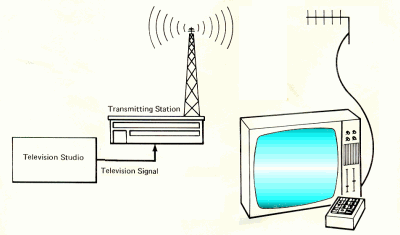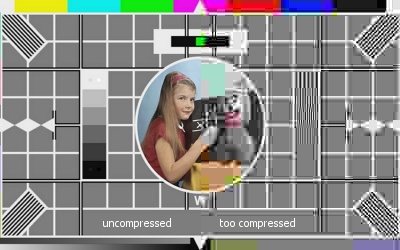Do I need to buy a booster?
 Brian Butterworth published on UK Free TV
Brian Butterworth published on UK Free TV With analogue television, it has often been necessary to buy an amplifier to improve the quality of the television picture, or to supply a steady on several televisions fed from the same aerial.
Many people have asked if it necessary to investing in a signal booster for Freeview.
"Analogue television" means is that the sound and pictures are broadcast using signals that are an "analogue" of the input. The sound and picture are transmitted from the source as electrical signals, then as radio waves and then back to sound and picture again.
In an analogue television camera, the image is scanned 25 times a second from side to side, from top to bottom and back. Where a lot of light is scanned, a high voltage is produced. Where no light is scanned, no voltage is produced. The output voltage is the same ratio to amount of light at scanned.
Leaving aside the technically, this signal is sent to the transmitter. The transmitter emits a radio wave on a known frequency, which is varied by the incoming voltage.

A microphone also converts the sound vibrations it picks up into a voltage, which when sent to the transmitter is added to another radio transmission frequency.
The signals are received by a television aerial pointing at the transmitter and converted back to very weak electrical signals. The sound is amplified and sent to a loudspeaker, and a picture created on the TV screen.
So on an analogue television, if the incoming signal is weak then the picture is dull as the background noise (the snow scene seen when an analogue television is not tuned) makes the picture less watchable.
The best analogue television set equipped with a great TV aerial located near to a high powered transmitter will produce brilliant pictures and clear sound. A poor set with an inadequate aerial or substandard cable will not.
If a weak signal is fed to a booster device, this will make the picture appear better on the television set or sets. It is often worth the investment.
Digital television
In a digital studio, the voltages from the cameras and microphones are not sent directly to the transmitter. It is converted into a stream of numbers inside a computer. The input voltage relates directly to the number in the computer. By sampling the input at a regular frequency, it is therefore possible to both store and transmit the information digitally this is what computers are good at.
It is therefore possible to take these numbers and generate a sound and picture output from them. However, the amount of information generated is over 240Mb/s, 30 times the rate of the fastest broadband connection.
Buy using computational techniques on this information the data can be compressed to as low as 2Mb/s, with as little as 6Mb/s being required for a good quality picture. These data compression techniques are called "lossy" because the reconstructed images are not identical to the originals, but look virtually similar to human eyes.

Digital television uses the same transmission frequencies as analogue uses, known as C21 to C68. The digital data is sent using a system called COFDM (Coded Orthogonal Frequency-Division-Multiplexing) which can carry data at a rate of 18Mb/s or 24Mb/s. Several television channels and some radio stations can be multiplexed together to produce exactly this amount of data.
At the receiver, it must be able to decode every single bit from these transmission multiplexes. A single error is impossible to correct for, so the decoder must have no errors.
Until switchover happens, the Freeview signals are being broadcast at very, very low power levels. However the COFDM system and sensitive digital equipment will, as long as the signal can be found and decoded there will be pixel-perfect reconstruction of the television channel. If the signal is drowned out by interference (especially from analogue transmissions) then no picture or sound will be output.
If the TV aerial installation you have provides you with all the Freeview channels, there is nothing to worry about.
If you are missing some channels because the signal is just too weak the best place to start is by improving the aerial, see Freeview reception - All about aerials. A bigger, higher, better designed aerial will always be the most sensible way to get perfect reception.
If you want to supply a signal to several sets, where the incoming signal is being "split" to serve several Freeview boxes, a masthead amplifier will be effective. This is because the signal is already of good quality and is being repeated for several sets.
However, if you are not getting a good signal from your aerial, a booster by the TV set will probably not help as this will simply boost the background interference as much as the Freeview signal.
In circumstances where an amplifier that has improved a picture on an analogue, it may be unsuitable for Freeview reception. Sometimes they will block one or more multiplex, where disconnecting the amplifier will restore the channels.
4:35 PM
Cassie: Covering the reflector with foil will have no effect whatsoever as far as your problem is concerned, and indeed a tri boom aerial is not the best of things to use for reception from Sandy whether mounted in the loft or not.
You would be far better using such as a Log 36 or DM log in conjunction with your aerial amplifier and with the aerial being mounted on a short right angled pole on either the fascia or soffit board (under the gutter) or alternatively directly onto the wall, although even if mounted in the loft you might find an improvement over the tri boom.
By the way, what is printed on your aerial amp as far as dB gain is concerned, 12dB being the lowest that I would recommend.
This is a link to the aerials referred to
Online FM DAB TV Aerial sales
| link to this comment |
6:40 PM
We have digital tv in our bedroom using the antenna on the roof ive put a splitter in back of tv then another cable going into kids tv but no signal on kids tv do i need a 2 or 3 booster in kids room to get a signal?
| link to this comment |
8:31 PM
steve: If you are meaning that you connected the aerial lead into the splitters "common" input and with a short jumper lead from one of the splitters outputs going into your TV and with the splitters second output used to feed the signal into the other room? then that's correct.
Maybe you could confirm (or otherwise) if you have connected the splitter up as per the method described? however if you have and nothing is being received on the second TV then apart from the fact that one of the two connectors used on the coax feeding the other room might have a short circuit on it (braiding touching middle connector) the other reason could be that your signal level is too low, especially if the feed is a bit lengthy, and should this apply then you will have to purchase a two way powered splitter instead of (I assume) the passive type presently used.
Unfortunately though the aspect of the signal level expected at your location cannot be assessed without having knowledge of your post code or at least one from nearby, e.g: a shop / post office.
| link to this comment |
8:42 PM
i have two tvs, the main one in the lounge and another in the spare bedroom. If i turn them both on the picture in the spare room breaks up...if i turn off the main tv then the picture on the other tv is fine. I have used a passive splitter .any ideas ?
| link to this comment |
8:57 PM
martin: If removing the feed from the splitter that goes into your lounge TV restores the picture in the spare bedroom then you require a two way powered splitter such as sold by Argos on page No 507.
Philex 18db 2 way booster item No 108 / 0287 @ £13.99.
| link to this comment |
2:11 PM
We have an Lg tv and all digital reception is fine for every channel.
however we also have a panasonic recordable twines tuner with incorporated DVD player with this we a missing a number of digital channels ie ITV3,5 USA etc.
Panasonic suggested a signal booster it made no difference. We live near Dover Kent.
Any ideas
| link to this comment |
3:58 PM
R Fulcher: a postcode would really help, but at a guess, your LG is tuned into a main transmitter, while the Recorder is tuned into another 'light' transmitter, hence the fewer channels.
| link to this comment |
5:58 PM
Deal
I live in a communal block of flats, i am using the ariel point in the flat, working ok, although some channels do have drop outs of video/audio, especially HD, would a plugin booster be ok to use?
Postcode CT14 7QF
| link to this comment |
Mark's: mapM's Freeview map terrainM's terrain plot wavesM's frequency data M's Freeview Detailed Coverage
Mark: I would suggest no because it is a communal system and therefore the system should be providing you with a good signal from the wall socket.
If this has been happening since switchover in June last year (and perhaps if it hasn't) then maybe the signal strength from the wall socket is a bit on the high side meaning that the amplifier (booster) within the aerial system could do with being turned down.
At switchover there was quite an increase in transmission power from Dover. The system may have been set-up for the weaker pre-switchover signals and now that the signals are stronger, it could be amplifying them too much.
| link to this comment |